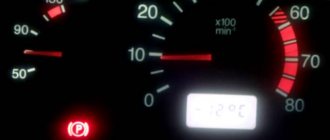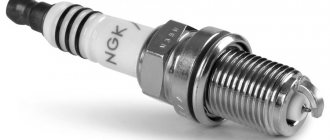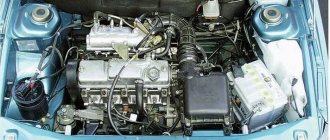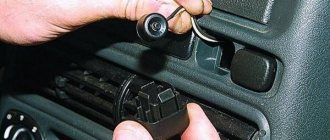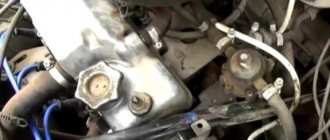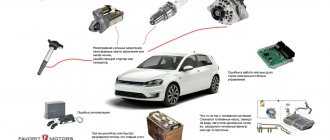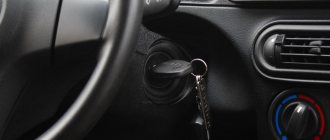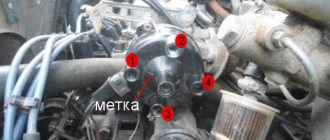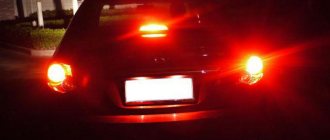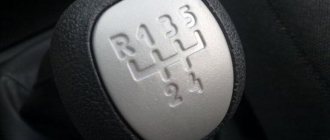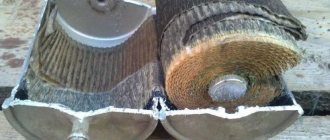After warming up the car, error 2115: rich mixture and with a sharp release of gas, a deep drop in speed.
- The idle speed does not drop, Samara 2 – 2 answers
- Error code 0340 in VAZ 2115 – 4 answers
- Dips at idle, VAZ 2115 – 4 answers
- The VAZ 2115 check light is constantly on - 4 answers
- Error on the instrument panel of VAZ 2114 - 3 answers
And the throttle assembly in the sink.
I wrote to you about the throttle position sensor, and not about what you listed. And bad gasoline also cannot be ruled out, but your engine runs smoothly and there are no jerks during acceleration or is that not so? A week ago I changed the air flow sensor with the same symptoms. But at first there were failures, after replacement a rich mixture was added to the failures (the Volt sensor was available), I installed the old one again, went and bought a new one and replaced it. I'm enjoying it.
Subscribe
to our channel in
Index.Zen
Even more useful tips in a convenient format
The idle speed does not drop, Samara 2
If, with a sharp release of gas, the engine speed drops to 400-500 rpm, then most likely the system simply does not have enough air due to a small leakage through the idle speed regulator. In order to get rid of the drop in speed on engines with a mechanical throttle, you need to tighten the throttle adjusting screw. On VAZ cars this screw is marked under the letter “B” and is usually painted over from the factory:
To fix the problem, it is necessary that the throttle valve be opened a little more when the gas pedal is not pressed. To do this, the screw should be turned clockwise. Using the method of test runs of the engine, determine the optimal position of this screw until the dips go away.
How to find the cause of the problem
If the speed of the VAZ 2114 drops, you need to comprehensively diagnose the functioning of the injection system on your car, which can be done in your garage if you have a little experience and appropriate instructions. In this case, those “fourteeners” that were equipped from the factory with a dashboard from the German manufacturer VDO have an important advantage, since it, in comparison with the analogue from Schetmash, is equipped with a self-diagnosis mode.
To carry out this procedure, you will need to perform a few simple steps:
- After turning off the engine, you need to keep the odometer button pressed for three to five seconds;
- Having turned the engine ignition to the first position, the button must be released;
- arrows should appear on the display, which is a signal of normal operation, then the button must be pressed the first time (displaying the firmware version) and the second time - after this probable errors in the ECU will be shown;
- To reset the error message, you will need to hold the button until a zero appears on the display.
After reading the manual, you can find out what errors shown on the screen may be associated with the fact that the speed constantly drops when the gas is released on the VAZ 2114.
So, it could be one of the following situations:
- code 1 – controller error;
- code 14/15 – coolant sensor error;
- code 22/23 – throttle position sensor error;
- code 33/34 – mass air flow sensor error;
- code 42 – faulty ignition;
- code 44 – fuel mixture is lean or too rich.
The owner of a VAZ 2114 should remember a specific feature of the self-diagnosis mode on his car: if there are several errors, the computer sums their codes arithmetically, which can be misleading. This can be indicated by a logical discrepancy between the displayed code and the actual problems.
To be completely sure, you will either need to take the car to a service center and pay for its inspection, or buy a diagnostic scanner yourself, which is not that expensive. Another option is if you have the same VAZ model (fully operational), one by one, remove it from it and install potentially vulnerable sensors on your car, using the method of elimination to find the problem.
Causes of failures when pressing the gas pedal
Let's look at the main reasons:
- Spark plugs and high-voltage wires;
- Clogged fuel injectors;
- The throttle valve is dirty;
- The ignition is set incorrectly;
- Errors in the ECU;
- The air filter is clogged;
- Problems with the fuel pump.
Often, failures occur due to a breakdown of the power system. After pressing the gas pedal, the power system increases the volume of fuel supplied to the cylinders. Breakage causes a change in these proportions. Those. The motor just can't do its job.
In addition, it is possible that there may be a breakdown in the ignition system. It occurs much less frequently. It's either spark plugs or ignition wires. The spark plugs must be removed and checked. The presence of carbon deposits or too clean spark plugs indicate a rich or lean fuel mixture, respectively. This indicates that the ignition system is adjusted incorrectly.
Dips when pressing the gas pedal during acceleration
It is determined both using computer diagnostics and by the steps described below (some of the points below can be performed independently, but specialists in car services in Moscow will be able to determine the problem area more quickly and accurately):
- The first thing you need to do is inspect the spark plugs. To do this you need to remove them. The presence of carbon deposits on the spark plugs, poor contact with the wires, or an excessively lean or rich mixture lead to spark plug malfunctions.
- High voltage wires can also cause engine malfunction, as can ignition coils.
- The throttle needs to be checked. If it is clogged, this causes the engine to respond untimely when pressing the gas pedal.
- It is necessary to check the condition of the air, fuel and oil filters. They tend to get clogged, which worsens dynamics, increases fuel consumption and causes pedal failure. They need to be changed constantly, you can do it yourself, they are inexpensive and easy to install.
- The presence of errors in the ECU leads to failures.
- Clogged injectors. If necessary, replace or repair injectors.
The wires, as well as the rubber bands on them, should not be damaged and should not spark when the engine is running. If damage is found, this indicates that the engine is shaking and jerking begins. This may occur due to the age of the car, worn-out or low-quality spare parts, poor contact with the spark plugs, or due to the temperature of the engine.
The resistance of the coils and the temperature change together, as a result of which a gasoline car begins to jerk during acceleration. In diesel cars, jerking cannot be associated with the coils, since they are not present.
Dips when pressing the gas pedal at idle
Problems also occur at idle speed; of course, there will be fewer reasons. However, this is also a serious problem and cannot be ignored, because... The car will have difficulty starting and simply stall.
Troubleshooting is performed in the following order:
- The first thing to check is the spark plugs. If the spark plugs are faulty, they should be replaced. We recommend replacing all spark plugs at the same time. Buy spark plugs specifically for your engine. If necessary, adjust the gap; it should be 1 mm for 92 gasoline.
- The fuel filter and fuel pump diagnostics are checked. If a malfunction is identified, fix it.
- The breakdown may be in the idle speed sensor.
- Checking the injectors. If clogged, replacement or cleaning is necessary.
- Diagnostics of the ECU for errors.
- Checking the injector.
Finding a breakdown without using the on-board controller
External “symptoms” of the behavior of a car and, in particular, its engine can also give a lot of food for thought to an experienced and observant driver. By analyzing these factors, you can significantly reduce the list of probable causes of the problem.
For example, it is necessary to track the moment the engine randomly turns off - at idle, during a “cold” start, after the engine has warmed up to a specific temperature, or when the gas pedal is sharply pressed.
In addition, you should pay attention to whether the speed drops with constant throttle application, and how the engine behaves when braking, releasing the gas pedal and turning off the gear?
Along with visual and auditory diagnostics, it would be useful to check in a circle potentially vulnerable components that could lead to the VAZ 2114 stalling when releasing the gas.
Firstly, you should start by checking the fuel and air filters - it is recommended to change them every 30 thousand kilometers, but in fact, operating conditions and the quality of the filters lead to the fact that in order to avoid problems it is better to halve this period (especially since in cars with With longer mileage, filters become clogged even faster).
In addition, you definitely need to check the fuel level in the tank, no matter how funny it may sound: the fuel level sensor often deceives the driver, and in addition, the car may simply be parked on a slope, which is why the fuel pump simply does not supply fuel to the engine - hence reason for the drop in speed.
A very common situation is the appearance of problems with ignition or maintaining speed after minor independent repairs: in this case, you need to check all the chips, contacts, terminals and wiring again to eliminate the usual human factor.
After revving the VAZ 2114, the speed drops
Hi all. We have the following problem: a VAZ-2114 car, manufactured in 2007, mileage 80,000 km, with power consumers (headlights, heater, etc.) on, the car almost stalls when the gas is released, the revolutions drop to 400-500. If you turn everything off, the motor works as it should. If you remove the wires from the generator, then everything works fine, because of this, the first thing they did was change the generator, it didn’t help. Then it was replaced: (or checked) IAC (2 times) DMRV spark plugs Measured compression (everywhere 12) Measured pressure in the fuel rail (about 3 points) Removed the fuel pump to check the mesh (perfectly clean) Reflashed the ECU Straightened the mass on the body, engine, ECU The throttle has been washed. There seems to be no air leakage from the mass air flow sensor to the throttle. Charging OK
Nothing helped! There is a suspicion that the 1st injector is faulty, because... In the 1st cylinder the spark plug is all smoked.
For clarity, I am posting a video of a faulty car (link No. 1) and for an example video (link No. 2) of the same car with all power consumers turned on (the standard, as it should be :))
Where to dig next?
